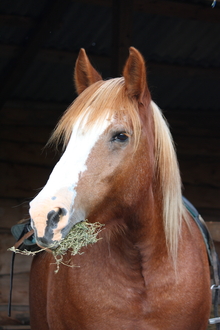If our horses could decide how to pass the time of day themselves, they would spend between 10 and 16 hours a day feeding. This is because the instinct to feed is in their genes.

Horse chewing high-fiber hay
Unlike humans, horses donât stop feeling hungry when their stomachs are full; appetite is controlled by satisfying the need to chew, so eating is also an important activity that contributes to the horseâs well-being.
Despite the fact that they are domesticated, their digestive systems are still designed to extract energy from high-fiber plant material. But unlike humans, horses donât stop feeling hungry when their stomachs are full; appetite is controlled by satisfying the need to chew. So eating is also an important activity that contributes to the horseâs well-being.
The closer their domesticated diet comes to meeting this ânatural nutritionâ state, the better off they are.
The first criteria when looking at a feed is how long it takes to eat, which is dependent on the structure of the feed. The higher the crude fiber content, the longer the animal will be busy with it.
Feeds that are rich in crude fiber include hay, straw and alfalfa. These natural roughage products, which contain coarse fibers which the horse has to work to grind down with its teeth, have several benefits: appropriate tooth wear, slower feed intake, more chewing activity and greater saliva formation. The latter plays a fundamental role in digestion as it softens the feed and makes it easier to swallow.
So natural roughage keeps the horse feeling fuller for longer, it is converted better and has a positive impact on all gastro-intestinal processes. Itâs no surprise that this indispensable crude fiber is described as the âengine of digestionâ.
But if rations only contain low levels of crude fiber, such as oats or barley, the horse chews very fast and the feed is not thoroughly mixed with saliva, causing gastro-intestinal problems when swallowed as a concentrated pulp.
A diet rich in fiber is particularly recommended for breeds of horses that are easy keepers, including ponies, small horses and hardy breeds such as Icelandics, Haflingers or Fjords.
This recommendation also applies to animals suffering from metabolic diseases such as EMS (Equine Metabolic Syndrome), Cushing Syndrome, PSSM (Polysaccharide Storage Myopathy), insulin resistance or laminitis. These animals also need rations that are low in starch and sugar in order to normalise hormonal imbalances. This is something that horse owners can only achieve with modified rations.
The ideal feed is one that achieves a balance between crude fiber and concentrate and delivers the benefits of both so as to boost the metabolism long-term â like Cavalor FiberForce. FiberForce consists of alfalfa stems and extruded pellets.
âWhy does my horse need alfalfa in its concentrate if it is already being fed hay?â you may wonder. Thatâs easy: because hay qualities differ greatly these days. Whatâs more, nutrient levels in crude fiber have plummeted in recent years, causing a long-term risk of nutrient deficiencies.
Cavalor FiberForce ensures a constant supply of nutrients and a consistently high quality, so it is also ideal for horses with a hay dust allergy or chronic respiratory diseases.
Another important component of Cavalor FiberForce is oil, which is used as a high quality source of energy. This particularly benefits older horses who have problems chewing or poor teeth and can only take in small quantities of roughage at a time.
Any shortage of crude fiber is compensated for by this liquid energy source. Cavalor FiberForce can also be used as supplementary feed or, under certain conditions, as a complete feed.
Not all high fiber / low sugar and starch feeds are created equal. Hereâs what to look for and why itâs important.
Highly digestible feed contains
- high levels of crude fiber
- low sugar content
- reduced starch content
- a secure source of energy
- no whole grains
Cavalor FiberForce was developed for horses with
- stomach ulcers
- gastro-intestinal problems
- insulin resistance
- laminitis
- EMS (Equine Metabolic Syndrome)
- Cushing Syndrome
- PSSM (Polysaccharide Speicher Myopathy)
- muscle problems
- chronic respiratory diseases
- postoperative problems
Cavalor Fiberforce (along with other Cavalor feeds, supplements and care products) can be found at a growing list of feed and supply companies nationally. To find a dealer near you, please visit http://cavaloruniversity.com/nutrition-partners/. To find out more, or get a personalized recommendation for your horseâs particular situation and needs, please call 855.228.2567 or email cavaloramerica@cavalor.com.
About Cavalor for equines:
Cavalor is the leading provider of equine feed and supplements specializing in high-performance horses. Founded in Belgium in 1989, the companyâs products are available in more than 50 countries worldwide and used by champion riders across the world. Cavalor has a longstanding commitment to supporting equestrian sports at their highest level and was Belgiumâs Official Animal Health and Nutrition Partner for the Alltech FEI World Equestrian Games 2010 as well as the Official Supplier for the Belgian Olympic Team at the 2012 London Olympics.
